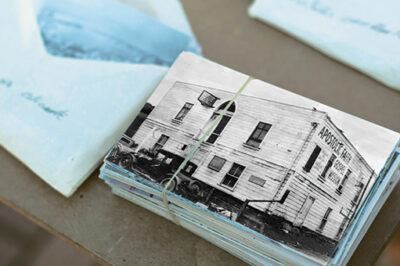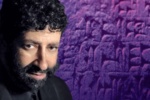From home prayer meetings to drafty tents to ornate seminary chapels, from sunny California to the backwoods of Kentucky to the gleaming cityscapes of New York, Toronto and beyond, the wind of the Holy Spirit has blown for more than a century in the Pentecostal-charismatic movement. Here are some of those who felt its warmth.
The Female Forerunner
The timid Ohio farm girl didn’t know in 1857, at age 13, what to do with God’s call to “go into the highways and hedges, and gather the lost sheep.” Her church didn’t even accept women in the pulpit. Maria Woodworth-Etter didn’t dare to speak publicly until she was 35. But soon people began responding to her salvation call. Her travels took her across America, from Chicago to Atlanta to San Francisco to Kansas City. Accounts of healing cures began to pile up. In Framingham, Massachusetts, she was arrested for practicing medicine without a license but was released when too many citizens came forward to affirm their healings. Her main defense: “The power of God which was given to the apostles in their day has never been taken from the church. Let the Holy Ghost work in any way that agrees with the Word of God.”
The Man Who Said ‘Yes, Lord’
The only denominational head to actually show up at the Azusa Street Mission (instead of just commenting from a distance) was Charles H. Mason, who had ridden the train nearly 2,000 miles from Memphis in March 1907 to see what this Spirit outpouring was all about. There he found Blacks such as himself shoulder to shoulder with whites, Mexicans, Chinese and others, all seeking God’s fullness—despite the Jim Crow laws of that era. He was impressed with the preaching, but got nervous when white brothers wanted to lay hands on him. “That night,” he later wrote, “the Lord spoke to me that Jesus saw all of this world’s wrongs but did not attempt to set [them] right until God overshadowed him with the Holy Ghost. And he said I was no better than my Lord … so I said yes to God.” Today, his Church of God in Christ (COGIC) is one of the five largest U.S. denominations.
Ignition on Azusa Street
Scorned by The Los Angeles Times as “an old colored exhorter” (though he was only 35), William J. Seymour was the lead elder of the Azusa Street Mission, where services ran daily for more than three years (1906-1909), starting midmorning and continuing late into the night. Wrote one eyewitness, “There was no pride there. Seeking souls could be found under the power almost any hour. … In that old building, with its low rafters and bare floor, God took strong men and women to pieces, and put them together again for His glory.” As for racial issues, “The color line was washed away in the blood.” The Azusa flame quickly spread across America, up into Canada, then Europe and around the globe. Seymour’s steady hand showed in his maxim, “We are measuring everything by the Word; every experience must measure up with the Bible. Some say that is going too far [being too restrictive], but if we have lived too close to the Word, we will settle that with the Lord when we meet Him in the air.”
Everybody’s ‘Sister’
Newspaper reporters in the 1920s and ’30s couldn’t seem to take their eyes off the high-energy, Canadian-born evangelist Aimee Semple McPherson. Stories ran continuously about her mass meetings, her pioneering radio station, her creative dramas, her floats in Los Angeles’ Rose Parade and the long lines of people waiting to get into Angelus Temple, the triple-deck church she built—the nation’s largest at the time (5,300 seats). Hollywood celebrities filled seats alongside common folk to hear what “Sister Aimee” called the Foursquare Gospel (Jesus Christ our Savior, healer, baptizer and soon-coming King). Future Academy Award-winning actor Anthony Quinn played trumpet in her orchestra; even Charlie Chaplin sneaked in one time to watch. Was this just a case of her megawatt personality? Perhaps it was her gutsy boldness to attempt what other women in that era would never have dared? No, she said. It all flowed from “a real baptism of the Holy Ghost and fire.”
The Boat-Rocker
Tradition had already settled into Pentecostal practice by the 1940s, as preachers said the one route to the Spirit’s infilling was to “tarry” at an altar, that is, to spend long hours begging (even crying) for the Spirit to come with a rush of tongues. J.E. (Jack) Stiles, a California pastor, began noticing that in at least three cases (Acts 8, 9, 19), believers received quickly through the laying on of hands. So he invited seekers to simply come sit on the front row of a church, stop any use of English, open their mouths and “breathe in” the Spirit of God. He would then go down the line touching each head, and within minutes, long-frustrated seekers would begin speaking in new vocabularies. As Stiles and his wife traveled for the next decade, she tried to keep track of the Spirit-baptisms, but finally gave up once she passed 10,000. The Stiles approach, though controversial at first, became mainstream as the charismatic renewal got underway.
Wholeness for Body and Mind
Growing up in China as the daughter of Presbyterian missionaries, Agnes Sanford loved God. But once she returned to the States, married an Episcopal rector and bore three children, she felt her life constrained and her energies drained by the demands of home and parish. When her youngest child (18 months old) developed an ear infection and fever that wouldn’t go away for six weeks, she grew even more despondent. Then a nearby Episcopal priest stopped by and prayed for him; the whimpering boy immediately fell into a sound sleep—and woke up well. From this point forward, Sanford began ministering freedom and joy to women under a cloud, and men as well. She never sought to speak to large audiences, but her book The Healing Light (1947) became a perennial bestseller. She became what some today call “the mother of the inner-healing movement.”
The Charismatic Cardinal
On Oct. 22, 1963, during the history-making Vatican II council, a senior Italian cardinal expressed his view that any charismatic gifts should be limited to the clergy. Leo Josef Suenens of Belgium openly disagreed. “These special gifts of the Holy Spirit to the church do exist today,” he said. “Without the shepherds, the church would be undisciplined; but without the charisms, it would be sterile. Therefore the pastors must heed the warnings of St. Paul and take care not to stifle the Spirit.” Thereafter Suenens became the pope’s unofficial liaison to Catholic charismatics worldwide. He was astute enough to admit that Pentecostals sometimes veered into excesses, but he said with a smile, “When you light a lamp in the darkness, you will draw some mosquitoes.” His wise writings continue to give guidance to this day, even drawing endorsement from the current leader of the Catholic Church, Pope Francis.
The Bridge Builder
When a roomful of Methodist clergy met with the South African David du Plessis to ask questions about the Holy Spirit’s work, they talked congenially for hours. At the end, the group raised a question: “Why is that you are the only Pentecostal we have yet found that will come to us in love and show such an interest in our spiritual welfare?” Du Plessis’ influence across wide swaths of the world, including North America and Europe, opened doors for him from the World Council of Churches to prestigious seminaries (Yale, Union, Princeton), earning him the nickname “Mr. Pentecost.” Even the pope gave him a medal in 1983 for “service to all Christianity.” As du Plessis often said, “To be Pentecostal you have to be ecumenical. … You cannot create unity. You cannot organize unity. But you must expect unity to come about by a creation of the Holy Spirit.”
Daughter of Destiny
To millions from the 1950s to the mid-1970s, Kathryn Kuhlman was a fresh channel of healing and blessing, “a veritable one-woman shrine of Lourdes” (Time magazine). To others, her style was over the top, melodramatic, “unbelievable corn,” wrote one nationally syndicated columnist. Whatever the opinions, crowds flocked to her meetings at Pittsburgh’s Carnegie Hall, complete with a massive choir; the same proved true when she added a monthly visit to Los Angeles’ Shrine Auditorium, which seated 7,000. Scores of people fell backward “under the power” at the soft touch of her hand—or even before she touched them. Her two TV programs, Your Faith and Mine and I Believe in Miracles, expanded her reach even further. Perhaps Grant Wacker (Duke Divinity School historian) summarized her best as “one of the key figures to transform the ‘down-home’ Pentecostal revival of the early 20th century into the ‘uptown’ charismatic movement of the late 20th century.”
Sounding the Alarm
The British-American revivalist Leonard Ravenhill would never have been tagged as a people-pleaser. Yet his 1959 book, Why Revival Tarries, grabbed the attention of sincere Christians everywhere with such statements as “The only reason we don’t have revival is because we are willing to live without it.” Another zinger: “The ugly fact is that altar fires are either out or burning very low. … By our attitude to prayer we tell God that what was begun in the Spirit we can finish in the flesh.” One young person who took his words at face value was firebrand singer-songwriter Keith Green, who called him “Papa.” Together, they challenged young and old alike to seek God with full heart and soul; the two men were so close they are buried nearly side by side in Garden Valley, Texas.
The Reluctant Rector
When Father Dennis Bennett dared in 1960 to tell his upscale Episcopal flock in Van Nuys, California, about his recent baptism in the Holy Spirit, it triggered immediate reaction, even protest. “We’re not a bunch of wild-eyed hillbillies!” one parishioner shouted after mounting a chair like a soapbox. “Throw out the [expletive] tongues-speakers!” yelled another. Newspapers picked up the story, and the bishop of Los Angeles sent out a pastoral letter banning tongues across the diocese, and Bennett wondered if he had torpedoed his future. But a warmer welcome was waiting at St. Luke’s Episcopal Church in Seattle, which steadily blossomed to become a center of renewal. The full story is told in the bestseller Nine O’Clock in the Morning. By the 1980s, a kinder bishop honored Bennett as a “canon of honor” for his work across the charismatic landscape.
Speak It, Believe It, Receive It
Wherever two or three charismatics are gathered together, there will be four or more opinions about Kenneth E. Hagin, father of the “Word of Faith” (or “Positive Confession”) movement. To some, his teachings opened the gates to a fuller life of spiritual, physical and material abundance. To others, his doctrine was seriously flawed. Regardless, his radio program Faith Seminar of the Air, his many self-published books and his Rhema Bible Training College in Broken Arrow, Oklahoma, set in motion a major influence among Pentecostals and charismatics. His tone was always congenial. And he was forthright enough at age 83 to call out some of the abuses he saw, writing a final book titled The Midas Touch: A Balanced Approach to Biblical Prosperity.
‘Expect a Miracle’
Say what? Don’t miracles just happen out of the blue, beyond the reach of human influence? Not according to Oral Roberts, the most famous figure of the post-World War II healing revival. He had experienced an instant healing from tuberculosis at age 17, and he confidently preached that “God is a good God!” (another of his signature phrases) through more than 300 major crusades, personally laying hands on as many as 2 million sufferers. Scoffers criticized, of course, but his nationally syndicated TV program rose to the top of the charts for almost 30 years. Today, the fully accredited university in Tulsa that bears his name trains graduates according to God’s original commission to Roberts: “to go where My light is dim, where My voice is heard small, and My healing power is not known, even to the uttermost bounds of the earth.”
Global Ambassadors
The rookie missionary couple T. L. and Daisy Osborn lasted less than a year in India before returning home defeated. The Muslims they had tried to reach with the gospel wanted proof that Jesus was alive today—and the Osborns had none. Two years later, they attended a healing meeting led by evangelist William Branham and discovered their missing link. By 1948, they were off to Jamaica, where hundreds were converted and many ailments cured. For the next 40 years they roamed the globe (Europe, Africa, Asia, Latin America) with stunning results. “What good is a church established by miracles if it ceases to perform miracles today?” T. L. asked. “The blind are not interested in His power to heal the blind only in Bible days. They need His healing today. Let us never depart from the example of the book of Acts.”
The Reconcilers
One man grew up in small-town Appalachia, the son of a Pentecostal Holiness pastor. The other was a pastor’s son, too—but grew up on the mean streets of Brooklyn. Both inhaled the cultural assumptions that Black was Black, and white was white, and never the twain would meet. But after both had become ministers themselves, Bishop Bernard Underwood (then chairman of an all-white Pentecostal collective) became convinced that things had to change. He reached out to Bishop Ithiel Clemmons (Church of God in Christ) in a spirit of repentance. Their friendship eventually resulted in the 1994 “Memphis Miracle” of reconciliation, spawning the all-new multiracial Pentecostal/Charismatic Churches of North America (PCCNA), with Clemmons as chairman and Underwood as vice-chairman—an organization that today numbers three times as many members as the previous one.
The Straight Shooter
New York City gangbangers were hardly the type to mince words, and neither was the young preacher who sought to bring them to Christ. When tough Nicky Cruz originally threatened to kill David Wilkerson, he replied, “You could do that, Nicky. You could cut me in a thousand pieces and lay them out on the street—and every piece would love you.” With grit and faith, he brought gang leaders (and their equally tough girlfriends) to salvation, eventually building the impressive ministry we know today as Teen Challenge. The power of the Spirit, he said, was the key to freedom that would last. “While he consistently preached hard against sin,” wrote one observer after his death in 2011, “that is arguably because he saw firsthand the toll sin could take on a life. Countless faces of helpless lives and the cries of hardened addicts perhaps kindled an anger of sorts … toward the enemy of our souls.”
On the Way to Majesty
He looked nothing like a Hollywood star—yet celebrities young and old from nearby movie lots joined thousands of ordinary folks at The Church on the Way to hear Jack Hayford open the Word of God. He wasn’t an eager promoter or networker; he gave more attention to drawing people into genuine worship. He wrote songs such as “Majesty” (eventually published in more than two dozen hymnals). Every Saturday night, he would go through his quiet sanctuary laying hands on every seat, asking God to touch whoever would sit there the next morning. This kind of earnest heart for God could not go unnoticed; he ended up speaking widely at events from the Lausanne II Congress on World Evangelization to Promise Keepers stadium rallies. In 2005 Christianity Today magazine put him on its cover as “The Pentecostal Gold Standard.”
In the ‘Radical Middle’
The longer the young John Wimber kept preaching through the Gospel of Luke, the more he kept running into healing stories (some two dozen). That frustrated him, since he’d never seen anybody healed through his efforts. But Jesus hadn’t done all the healing himself; sometimes it was the 12, or even the 72. Then came a breakthrough in early 1978, and from then on, healing and renewal were at the center of what became the Vineyard USA association of churches. He (and a friend, Dr. C. Peter Wagner) even taught a night class at the prestigious Fuller Theological Seminary called “Signs, Wonders & Church Growth,” which drew national media attention—and controversy. Wimber didn’t want to be pegged as either “Pentecostal” or “charismatic?” he said instead with a smile that he was somewhere in the “radical middle” of Christianity. He admitted that he would never understand everything about divine healing, “but I am satisfied to act on what I know now, confident that I will know more fully in the future.”
Up From the Barrio
Little Jesse Miranda was just 6 years old when he first climbed up into the Albuquerque church bus to ride to Sunday school. There they spoke about a Jesus who loved Mexican-Americans like him, would save them, even heal them. That was the start of his upward trail that gradually led to college, ordination, two master’s degrees and even a doctorate. He founded an alliance for Hispanic ministers, and eventually was invited by three U.S. presidents in a row (George H.W. Bush, Clinton, George W. Bush) to consult on Hispanic affairs. “Under the skin, we are all kin,” he wrote. “We are all members of the human race and familia. … The church must not see diversity as a problem to be solved but rather as a way to complete its prophetic identity. To this end, racial and ethnic groups are the social and spiritual capital of the body of Christ.”
Plundering Hell to Populate Heaven
Called to evangelize in Africa, Reinhard Bonnke faced several drawbacks. His skin was white, not black; his native language was German, not English or one of the other major African tongues. Not to be deterred, he campaigned for more than 40 years in nearly every one of the continent’s 54 nations and met face to face with 14 different heads of state, “plundering hell to populate heaven,” as he said. He preached in large tents at first, until his massive 34,000-seat tent blew apart in a Cape Town windstorm. After that, he took his meetings outdoors in parks and other open spaces, with floodlights, powerful sound systems and eventually large video screens around the perimeter. Crowds swelled into the hundreds of thousands.
Scholars for the World
When Korean-born Wonsuk Ma and his wife, Julie, began ministering among tribal people in the Philippines, they knew their academic degrees would carry little weight. “If we didn’t bring the powerful work of the Holy Spirit into this setting—confronting sickness or demon possession, for example—people would be unimpressed,” Wonsuk says. (He joked with his wife that her Ph.D. dissertation should have been entitled “When the Assemblies of God Meets the Assembly of ‘Gods.'”) With the help of supernatural power, they raised up more than 150 Filipino churches before moving across the globe in 2006 to England, where the prestigious Oxford Centre for Mission Studies sought their revitalizing leadership. In 2016 they moved again, this time to America to launch a Ph.D. program at Oral Roberts University.
READ MORE: For additional information on modern-day Pentecostalism, visit pentecostal.charismamag.com.
Dean Merrill is an award-winning author or co-author of multiple books who, with his wife, lives in Colorado Springs. His newest title is 50 Pentecostal and Charismatic Leaders Every Christian Should Know (Chosen Books, 2021).
This article was excerpted from the May issue of Charisma magazine. If you don’t subscribe to Charisma, click here to get every issue delivered to your mailbox. During this time of change, your subscription is a vote of confidence for the kind of Spirit-filled content we offer. In the same way you would support a ministry with a donation, subscribing is your way to support Charisma. Also, we encourage you to give gift subscriptions at shop.charismamag.com, and share our articles on social media.







Leave a Comment
You must be logged in to post a comment.